Abstract
To investigate mechanisms of pulmonary edema in respiratory failure, we studied unanesthetized sheep with vascular catheters, pleural balloons, and chronic lung lymph fistulas. Animals breathed either a hypercapnic-enriched oxygen (n = 5) or a hypercapnic-hypoxic (n = 5) gas mixture for 2 h. Every 15 min blood gases, pressures, cardiac output, lymph flow (Qlym), plasma and lymph albumin (mol wt, 70,000), IgG (mol wt, 150,000), IgM (mol wt, 900,000), and blood bradykinin concentrations were determined. In both groups, cardiac output and pulmonary arterial pressures increased, whereas left atrial pressures were unchanged. Acidosis alone (arterial pH = 7.16, PaCO2 = 81 mm Hg, PaO2 = 250 mm Hg) resulted in a doubling of lymph flow, a small increase in protein flux, and a decrease in lymph to plasma protein concentration (L/P) ratio for all three proteins. Acidotic-hypoxic animals (arterial pH = 7.16, PaCO2 = 84 mm Hg, PaO2 = 48 mm Hg) tripled Qlym. In these animals the increase in lymphatic flux of albumin, IgG, and IgM was significantly (P < 0.05) greater than that seen in either the acidosis alone group or in animals where left atrial pressures were elevated (n = 5; P < 0.05). Also, their percent increase in flux of the large protein (IgM) was greater than for the small protein (albumin) (P < 0.05). With acidosis alone, only pulmonary arterial bradykinin concentration increased (1.27±0.25 ng/ml SE), whereas acidosis plus hypoxia elevated both pulmonary arterial bradykinin concentrations (4.83±1.14 ng/ml) and aortic bradykinin concentration (2.74±0.78 ng/ml). These studies demonstrate that hypercapnic acidosis stimulates in vivo production of bradykinin. With superimposed hypoxia, and therefore decreased bradykinin degradation, there is an associated sustained rise in Qlym with increased lung permeability to proteins.
Full text
PDF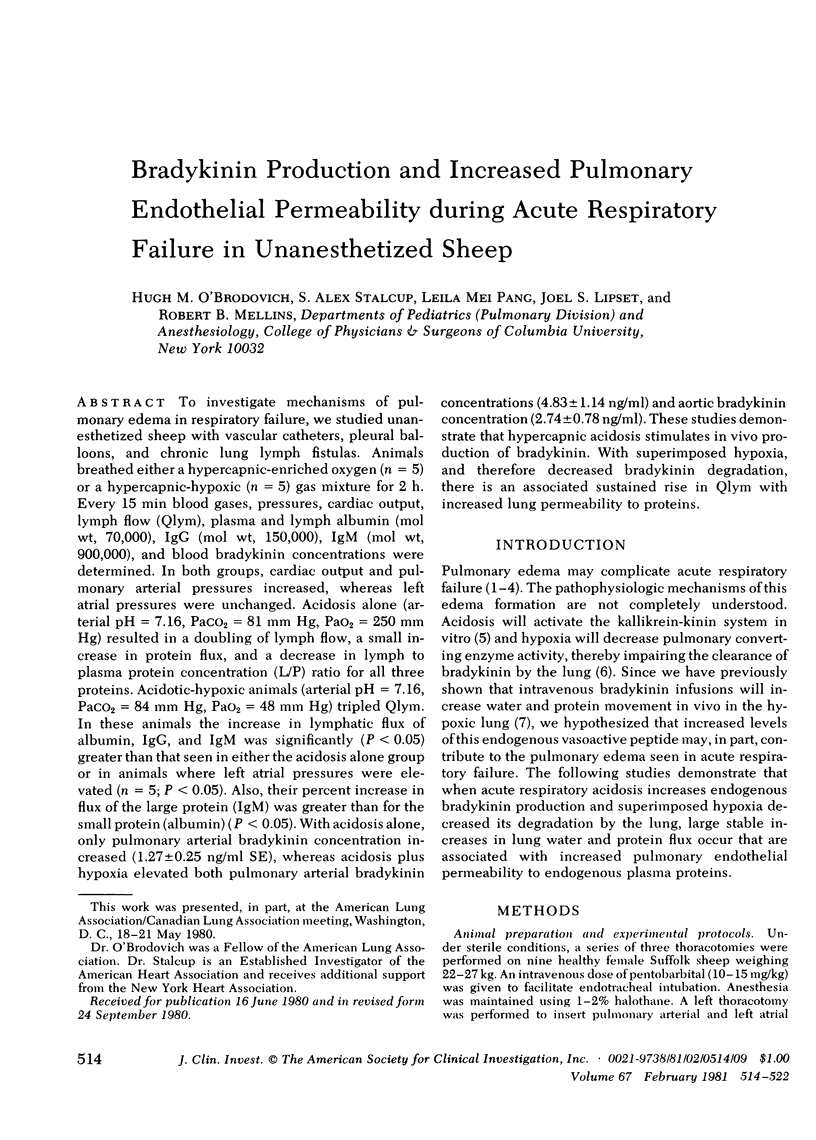
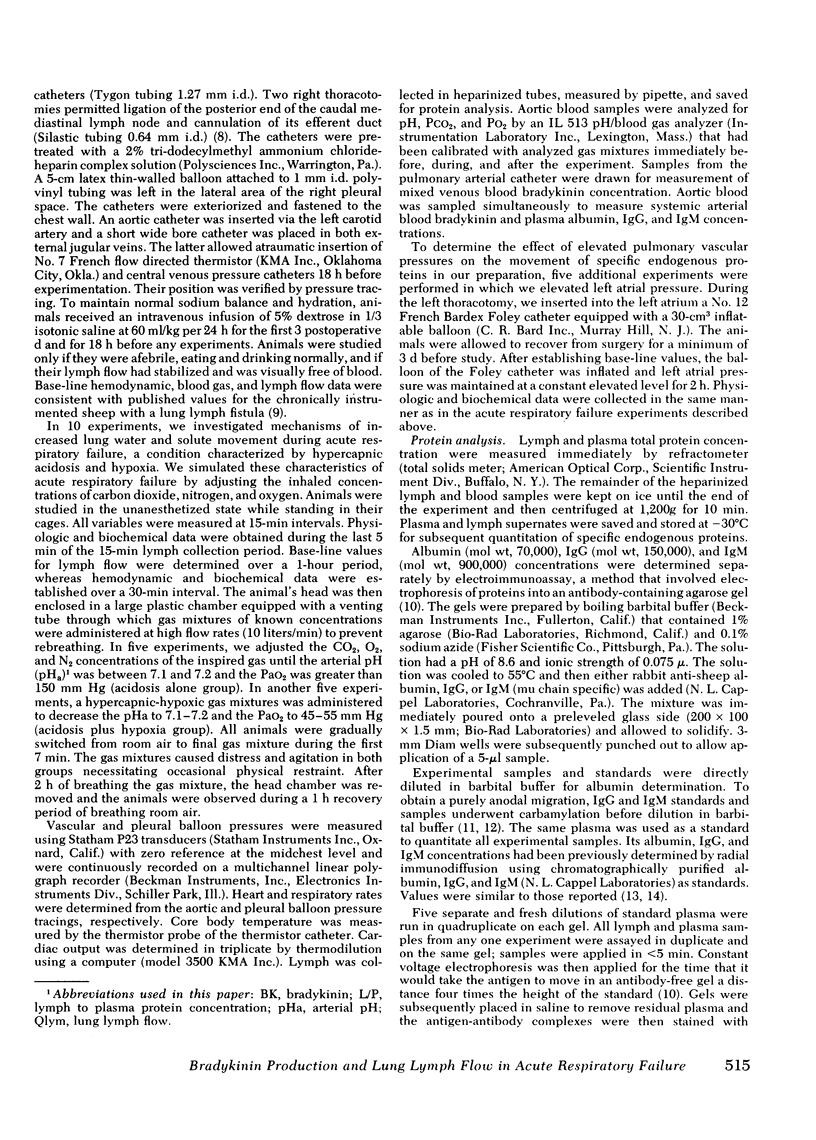
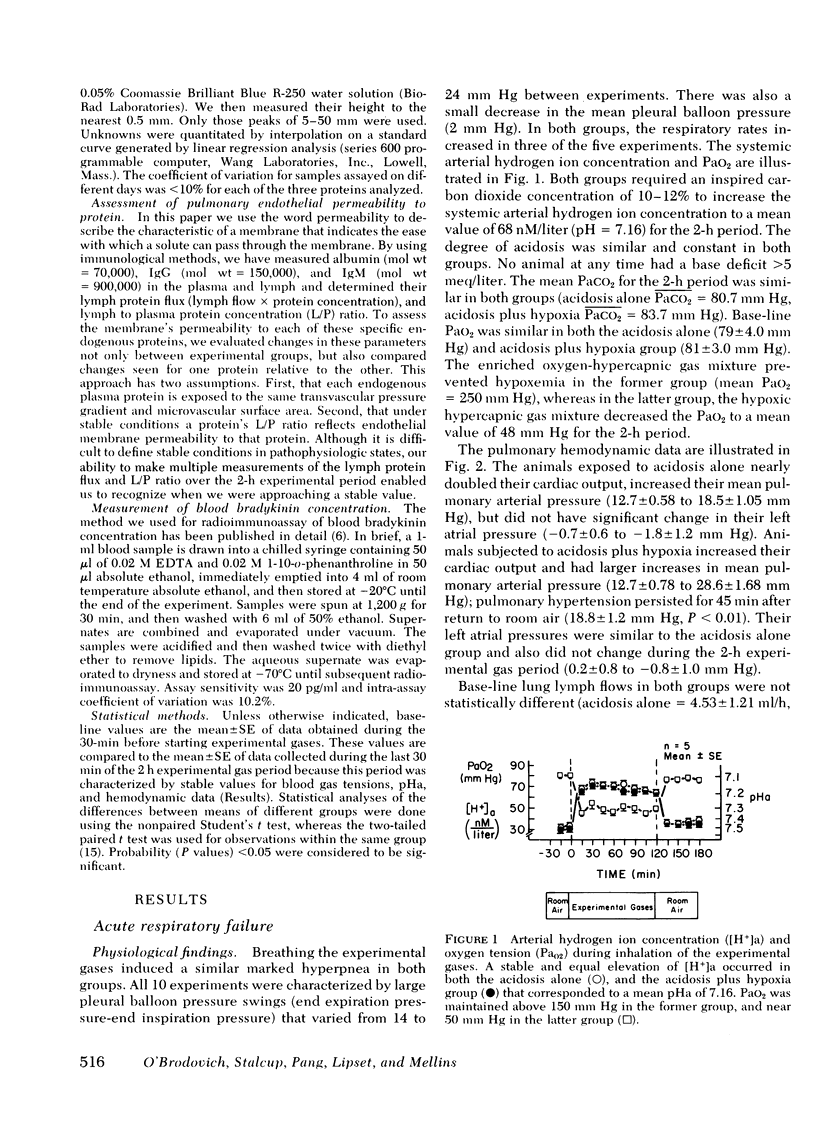
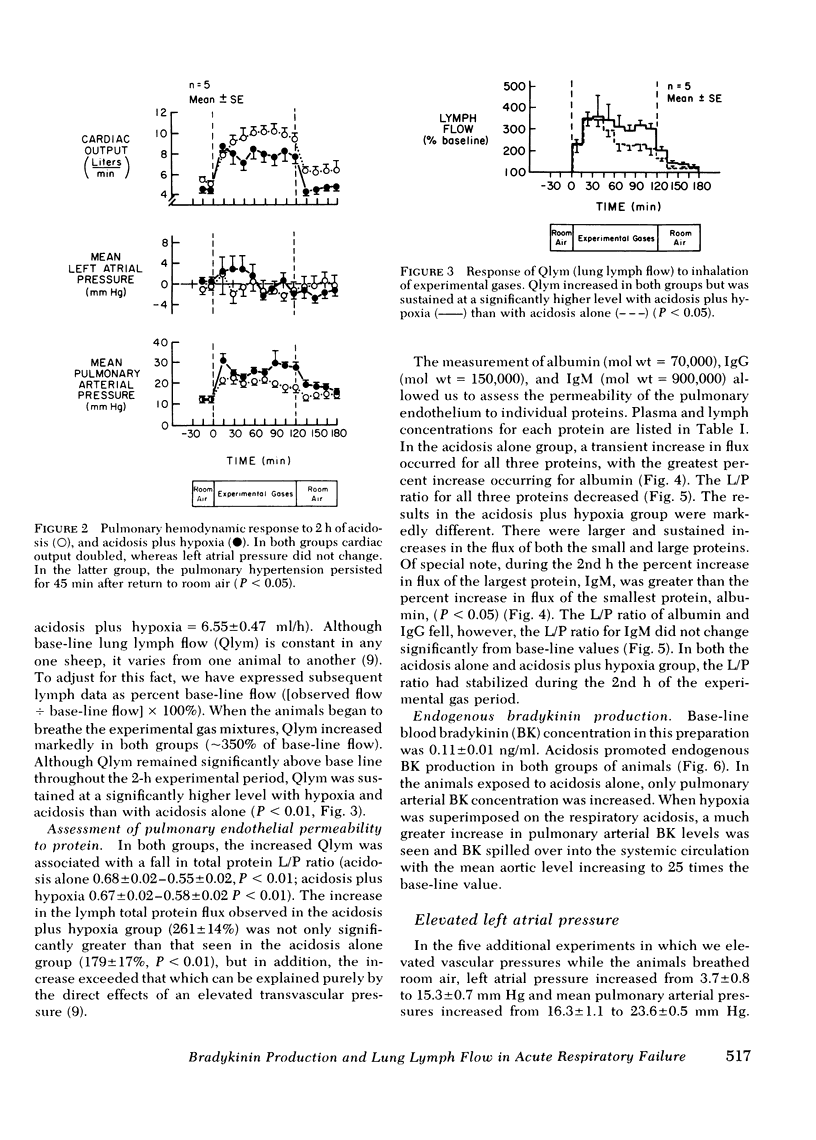
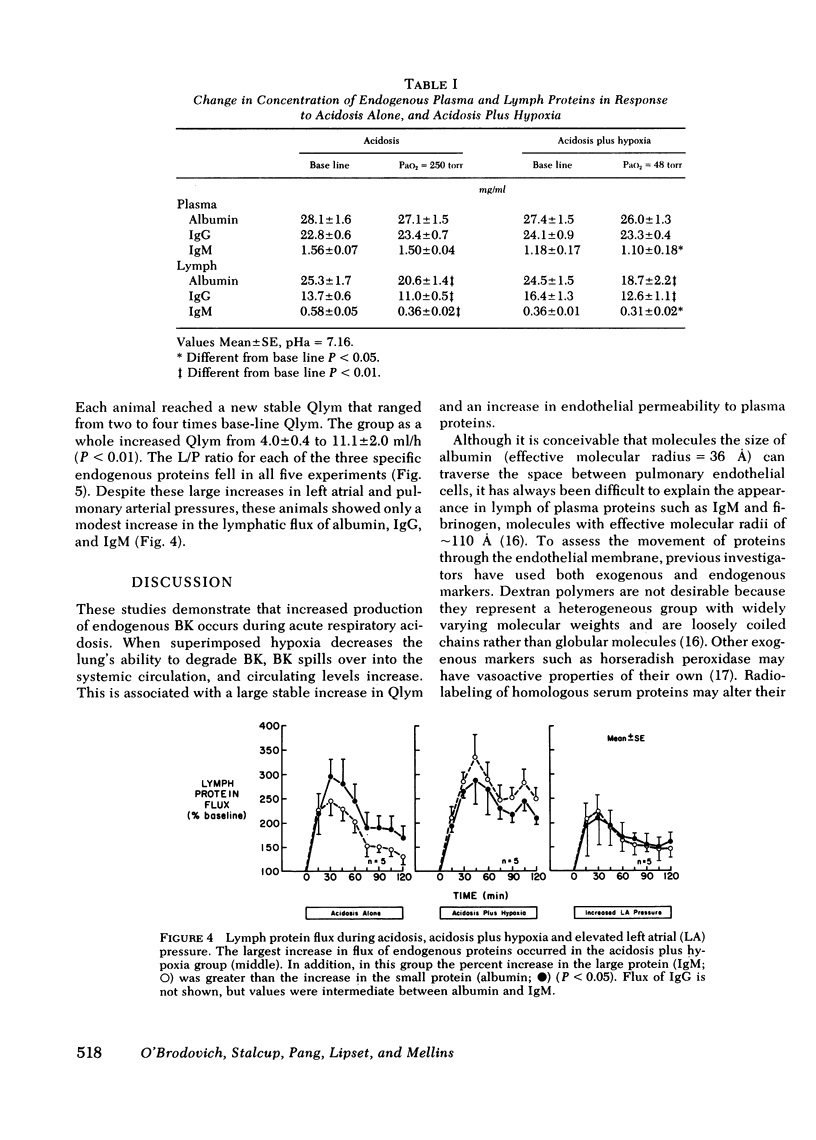
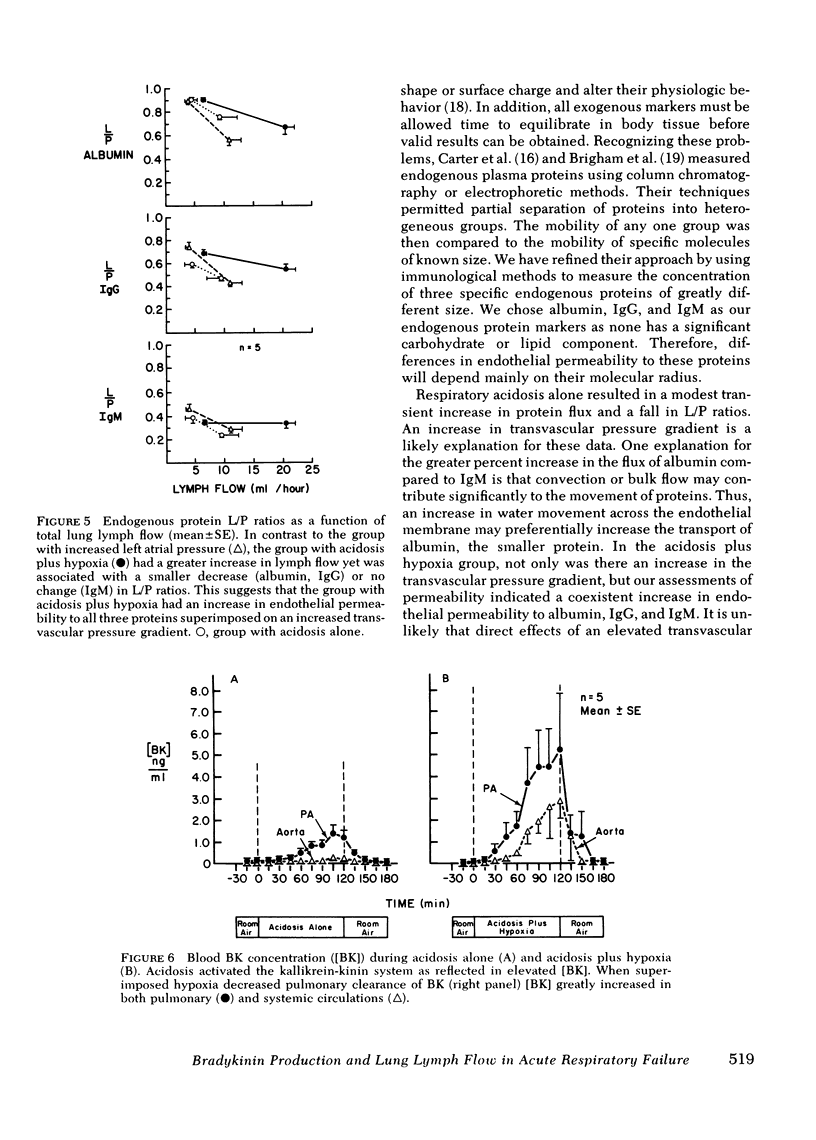
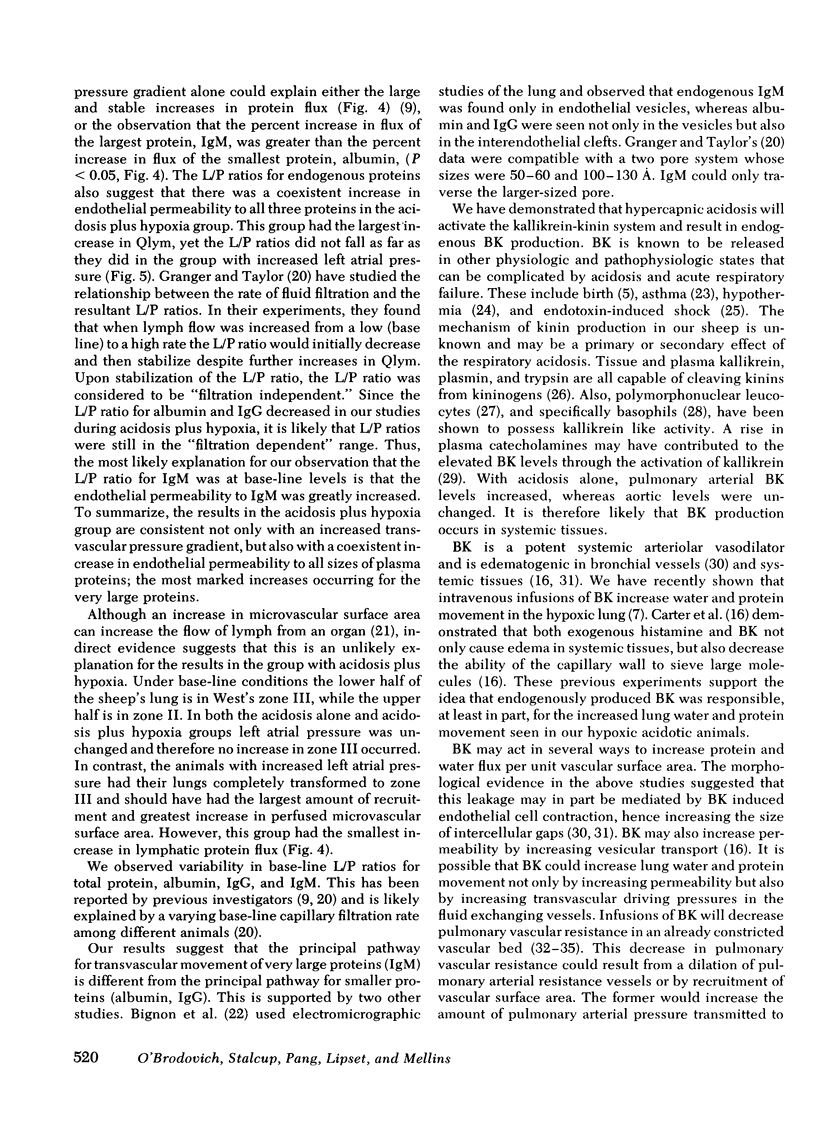
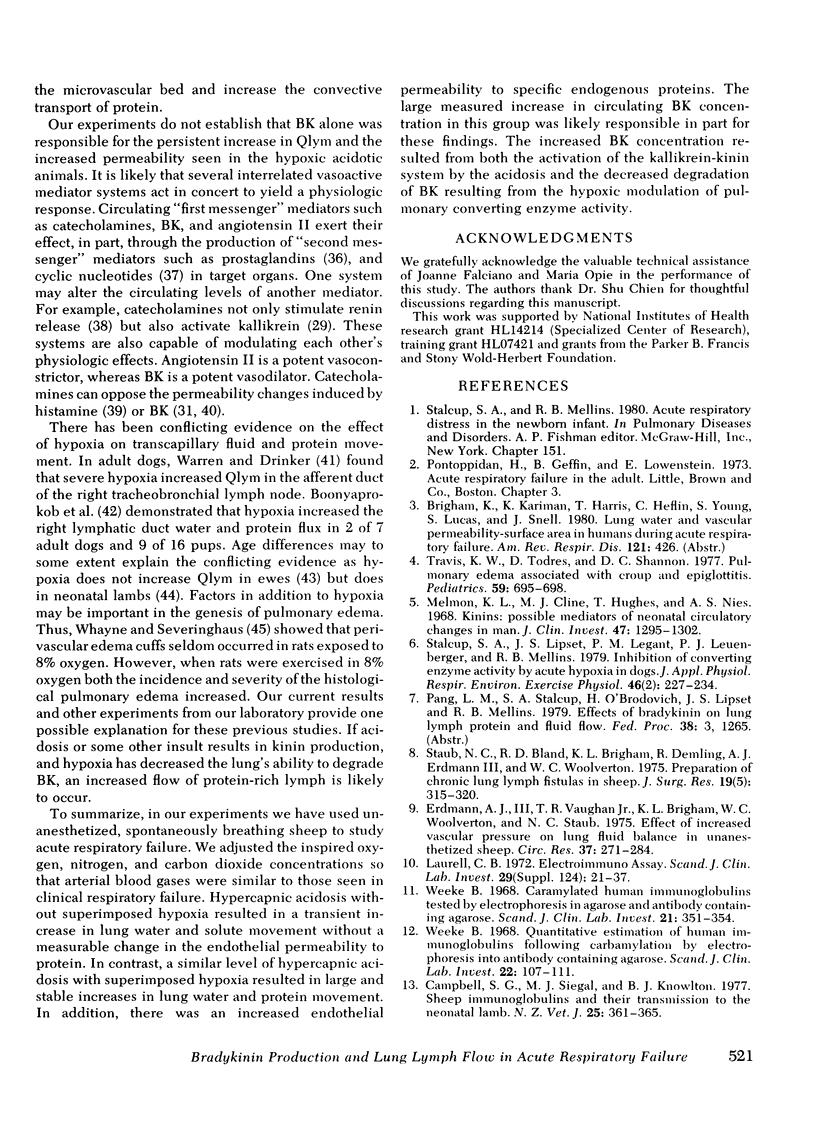
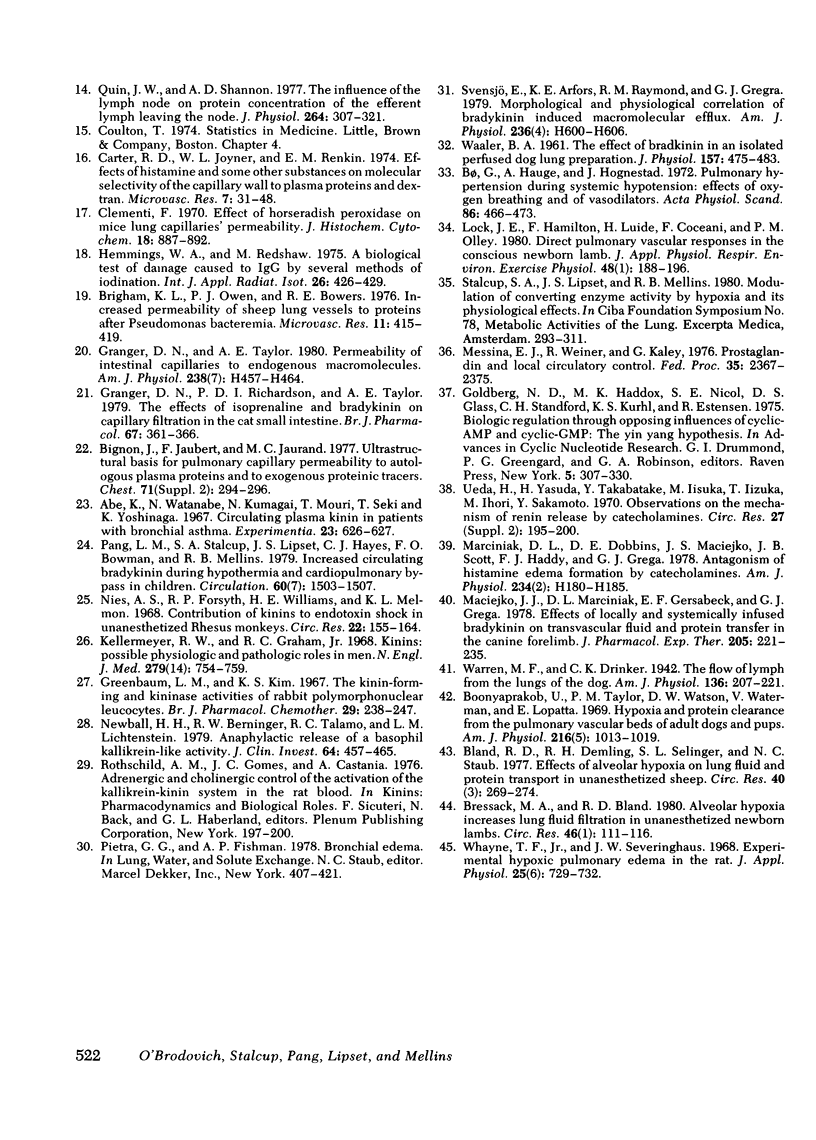
Selected References
These references are in PubMed. This may not be the complete list of references from this article.
- Abe K., Watanabe N., Kumagai N., Mouri T., Seki T., Yoshinaga K. Circulating kinin in patients with bronchial asthma. Experientia. 1967 Aug 15;23(8):626–627. doi: 10.1007/BF02144161. [DOI] [PubMed] [Google Scholar]
- Bignon J., Jaubert F., Jaurand M. C. Ultrastructural basis for pulmonary capillary permeability to autologous plasma proteins and to exogenous proteinic tracers. Chest. 1977 Feb;71(2 Suppl):294–296. doi: 10.1378/chest.71.2.294. [DOI] [PubMed] [Google Scholar]
- Bland R. D., Demling R. H., Selinger S. L., Staub N. C. Effects of alveolar hypoxia on lung fluid and protein transport in unanesthetized sheep. Circ Res. 1977 Mar;40(3):269–274. doi: 10.1161/01.res.40.3.269. [DOI] [PubMed] [Google Scholar]
- Bo G., Hauge A., Hognestad J. Pulmonary hypertension during systemic hypotension. Effects of oxygen breathing and of vasodilators. Acta Physiol Scand. 1972 Dec;86(4):466–473. [PubMed] [Google Scholar]
- Boonyaprakob U., Taylor P. M., Watson D. W., Waterman V., Lopata E. Hypoxia and protein clearance from the pulmonary vascular beds of adult dogs and pups. Am J Physiol. 1969 May;216(5):1013–1019. doi: 10.1152/ajplegacy.1969.216.5.1013. [DOI] [PubMed] [Google Scholar]
- Bressack M. A., Bland R. D. Alveolar hypoxia increases lung fluid filtration in unanesthetized newborn lambs. Circ Res. 1980 Jan;46(1):111–116. doi: 10.1161/01.res.46.1.111. [DOI] [PubMed] [Google Scholar]
- Brigham K. L., Owen P. J., Bowers R. E. Increased permeability of sheep lung vessels to proteins after Pseudomonas bacteremia. Microvasc Res. 1976 May;11(3):415–419. doi: 10.1016/0026-2862(76)90067-4. [DOI] [PubMed] [Google Scholar]
- Campbell S. G., Siegel M. J., Knowlton B. J. Sheep immunoglobulins and their transmission to the neonatal lamb. N Z Vet J. 1977 Dec;25(12):361–365. doi: 10.1080/00480169.1977.34458. [DOI] [PubMed] [Google Scholar]
- Carter R. D., Joyner W. L., Renkin E. M. Effects of histamine and some other substances on molecular selectivity of the capillary wall to plasma proteins and dextran. Microvasc Res. 1974 Jan;7(1):31–48. doi: 10.1016/0026-2862(74)90035-1. [DOI] [PubMed] [Google Scholar]
- Clementi F. Effect of horseradish peroxidase on mice lung capillaries' permeability. J Histochem Cytochem. 1970 Dec;18(12):887–892. doi: 10.1177/18.12.887. [DOI] [PubMed] [Google Scholar]
- Erdmann A. J., 3rd, Vaughan T. R., Jr, Brigham K. L., Woolverton W. C., Staub N. C. Effect of increased vascular pressure on lung fluid balance in unanesthetized sheep. Circ Res. 1975 Sep;37(3):271–284. doi: 10.1161/01.res.37.3.271. [DOI] [PubMed] [Google Scholar]
- Goldberg N. D., Haddox M. K., Nicol S. E., Glass D. B., Sanford C. H., Kuehl F. A., Jr, Estensen R. Biologic regulation through opposing influences of cyclic GMP and cyclic AMP: the Yin Yang hypothesis. Adv Cyclic Nucleotide Res. 1975;5:307–330. [PubMed] [Google Scholar]
- Granger D. N., Richardson P. D., Taylor A. E. The effects of isoprenaline and bradykinin on capillary filtration in the cat small intestine. Br J Pharmacol. 1979 Nov;67(3):361–366. doi: 10.1111/j.1476-5381.1979.tb08688.x. [DOI] [PMC free article] [PubMed] [Google Scholar]
- Granger D. N., Taylor A. E. Permeability of intestinal capillaries to endogenous macromolecules. Am J Physiol. 1980 Apr;238(4):H457–H464. doi: 10.1152/ajpheart.1980.238.4.H457. [DOI] [PubMed] [Google Scholar]
- Greenbaum L. M., Kim K. S. The kinin-forming and kininase activities of rabbit polymorphonuclear leucocytes. Br J Pharmacol Chemother. 1967 Feb;29(2):238–247. doi: 10.1111/j.1476-5381.1967.tb01956.x. [DOI] [PMC free article] [PubMed] [Google Scholar]
- Hemmings W. A., Redshaw M. A biological test of damage caused to IgG by several methods of iodination. Int J Appl Radiat Isot. 1975 Jun-Jul;26(6-7):426–429. doi: 10.1016/0020-708x(75)90052-6. [DOI] [PubMed] [Google Scholar]
- Kellermeyer R. W., Graham R. C., Jr Kinins--possible physiologic and pathologic roles in man. N Engl J Med. 1968 Oct 3;279(14):754–759. doi: 10.1056/NEJM196810032791406. [DOI] [PubMed] [Google Scholar]
- Laurell C. B. Electroimmuno assay. Scand J Clin Lab Invest Suppl. 1972;124:21–37. doi: 10.3109/00365517209102748. [DOI] [PubMed] [Google Scholar]
- Lock J. E., Hamilton F., Luide H., Coceani F., Olley P. M. Direct pulmonary vascular responses in the conscious newborn lamb. J Appl Physiol Respir Environ Exerc Physiol. 1980 Jan;48(1):188–196. doi: 10.1152/jappl.1980.48.1.188. [DOI] [PubMed] [Google Scholar]
- Maciejko J. J., Marciniak D. L., Gersabeck E. F., Grega G. J. Effects of locally and systemically infused bradykinin on transvascular fluid and protein transfer in the canine forelimb. J Pharmacol Exp Ther. 1978 Apr;205(1):221–235. [PubMed] [Google Scholar]
- Marciniak D. L., Dobbins D. E., Maciejko J. J., Scott J. B., Haddy F. J., Grega G. J. Antagonism of histamine edema formation by catecholamines. Am J Physiol. 1978 Feb;234(2):H180–H185. doi: 10.1152/ajpheart.1978.234.2.H180. [DOI] [PubMed] [Google Scholar]
- Melmon K. L., Cline M. J., Hughes T., Nies A. S. Kinins: possible mediators of neonatal circulatory changes in man. J Clin Invest. 1968 Jun;47(6):1295–1302. doi: 10.1172/JCI105821. [DOI] [PMC free article] [PubMed] [Google Scholar]
- Messina E. J., Weiner R., Kaley G. Prostaglandins and local circulatory control. Fed Proc. 1976 Oct;35(12):2367–2375. [PubMed] [Google Scholar]
- Newball H. H., Berninger R. W., Talamo R. C., Lichtenstein L. M. Anaphylactic release of a basophil kallikrein-like activity. I. Purification and characterization. J Clin Invest. 1979 Aug;64(2):457–465. doi: 10.1172/JCI109483. [DOI] [PMC free article] [PubMed] [Google Scholar]
- Nies A. S., Forsyth R. P., Williams H. E., Melmon K. L. Contribution of kinins to endotoxin shock in unanesthetized Rhesus monkeys. Circ Res. 1968 Feb;22(2):155–164. doi: 10.1161/01.res.22.2.155. [DOI] [PubMed] [Google Scholar]
- Pang L. M., Stalcup S. A., Lipset J. S., Hayes C. J., Bowman F. O., Jr, Mellins R. B. Increased circulating bradykinin during hypothermia and cardiopulmonary bypass in children. Circulation. 1979 Dec;60(7):1503–1507. doi: 10.1161/01.cir.60.7.1503. [DOI] [PubMed] [Google Scholar]
- Quin J. W., Shannon A. D. The influence of the lymph node on the protein concentration of efferent lymph leaving the node. J Physiol. 1977 Jan;264(2):307–321. doi: 10.1113/jphysiol.1977.sp011670. [DOI] [PMC free article] [PubMed] [Google Scholar]
- Stalcup S. A., Lipset J. S., Legant P. M., Leuenberger P. J., Mellins R. B. Inhibition of converting enzyme activity by acute hypoxia in dogs. J Appl Physiol Respir Environ Exerc Physiol. 1979 Feb;46(2):227–234. doi: 10.1152/jappl.1979.46.2.227. [DOI] [PubMed] [Google Scholar]
- Stalcup S. A., Lipset J. S., Mellins R. B. Modulation of converting enzyme activity by hypoxia and its physiological effects. Ciba Found Symp. 1980;78:293–311. doi: 10.1002/9780470720615.ch16. [DOI] [PubMed] [Google Scholar]
- Staub N. C., Bland R. D., Brigham K. L., Demling R., Erdmann A. J., 3rd, Woolverton W. C. Preparation of chronic lung lymph fistulas in sheep. J Surg Res. 1975 Nov;19(5):315–320. doi: 10.1016/0022-4804(75)90056-6. [DOI] [PubMed] [Google Scholar]
- Svensjö E., Arfors K. E., Raymond R. M., Grega G. J. Morphological and physiological correlation of bradykinin-induced macromolecular efflux. Am J Physiol. 1979 Apr;236(4):H600–H606. doi: 10.1152/ajpheart.1979.236.4.H600. [DOI] [PubMed] [Google Scholar]
- Travis K. W., Todres I. D., Shannon D. C. Pulmonary edema associated with croup and epiglottitis. Pediatrics. 1977 May;59(5):695–698. [PubMed] [Google Scholar]
- Ueda H., Yasuda H., Takabatake Y., Iizuka M., Iizuka T. Observations on the mechanism of renin release by catecholamines. Circ Res. 1970 Oct;27(Suppl):195+–195+. [PubMed] [Google Scholar]
- WAALER B. A. The effect of bradykinin in an isolated perfused dog lung preparation. J Physiol. 1961 Aug;157:475–483. doi: 10.1113/jphysiol.1961.sp006737. [DOI] [PMC free article] [PubMed] [Google Scholar]
- Weeke B. Carbamylated human immunoglobulins tested by electrophoresis in agarose and antibody containing agarose. Scand J Clin Lab Invest. 1968;21(4):351–354. doi: 10.3109/00365516809077006. [DOI] [PubMed] [Google Scholar]
- Weeke B. Quantitative estimation of human immunoglobulins following carbamylation by electrophoresis in antibody-containing agarose. Scand J Clin Lab Invest. 1968;22(2):107–111. doi: 10.3109/00365516809160953. [DOI] [PubMed] [Google Scholar]
- Whayne T. F., Jr, Severinghaus J. W. Experimental hypoxic pulmonary edema in the rat. J Appl Physiol. 1968 Dec;25(6):729–732. doi: 10.1152/jappl.1968.25.6.729. [DOI] [PubMed] [Google Scholar]


